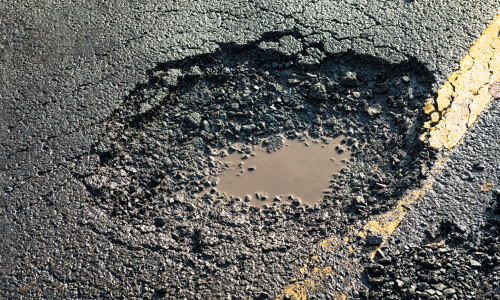Pothole Problems And What To Look Out For

Potholes can be a real problem for road users, causing damage to our cars, and sometimes even breakdowns. Other than the need to avoid them, what else should you know about these nuisances that occur on our roads?
Why are potholes a problem?
Driving into a pothole can be dangerous for you and your vehicle. Depending on the speed you hit one, your wheels, tyres, steering or suspension could be damaged, and the loose chippings from potholes can cause serious windscreen damage too. Potholes can also lead to more dangerous consequences, as accidents can occur when motorists swerve or brake suddenly to avoid them, or motorcyclists lose balance if they hit one.
Is it possible to avoid a pothole?
Leaving plenty of distance between you and the car in front is part of rule 126 of the Highway Code but it can also help you to see any changes in the condition of the road ahead. Using the ‘two second rule’, where you leave a two second gap between yourself and the car in front of you, can help you to make sure you’re doing this. Driving below the speed limit and in a way that’s suitable for the road conditions will also give you more time to see and avoid a pothole, when it is safe to do so. Be aware of puddles that could hide large potholes in wet conditions too.
Why do potholes keep coming back?
Potholes form when the tarmac weakens and cracks due to adverse weather conditions and traffic impact. This allows water to seep in to the sand and stone underneath, washing everything away and causing an ever-expanding hole. The wet, cold climate in the UK during the winter months is why we see so many of them across the country.

What do I do if I hit a pothole?
When it’s safe to do so, pull over to check if there’s been any obvious damage to your car. If you keep driving with a cracked wheel, blown out tyre or steering issues this can be very dangerous for you and other road users. Even if there’s no visible damage, if you think there could be anything wrong, it’s best to get your car checked over by a mechanic to make sure.
It’s always a good idea to keep any breakdown cover details you may have to hand, just in case you’re unable to continue your journey because of any damage.
How can I report a pothole?
Depending on whether you’re in England, Wales or Scotland there are different websites where you can report potholes and other road surface issues. You’ll need to have the location of the pothole to begin with and will then be asked various other questions to help the relevant local authority decide how to deal with it.
England and Wales https://www.gov.uk/report-pothole
Scotland https://www.mygov.scot/report-pothole
Can I claim for any damage?
If your car is damaged by a pothole, you might be able to make a claim for this from the local authority or agency taking responsibility for the area in which the pothole is. The details of how to do this are listed here.
If hitting (or avoiding) the pothole resulted in an accident and you need to make a claim on your car insurance, make sure you have all the details to hand including any photos, dashcam footage, incident location and time. You can make a claim online by logging in to your Account and choosing ‘make a claim’. If you need our emergency accident recovery team please call on 0345 603 7872, we’re available 24/7.
While potholes are unfortunately something all drivers are likely to come across at some point, we hope this article has helped you understand how you can avoid them, and what to do if you do end up hitting one.
Buying an Electric Vehicle or hybrid? 9 things you should know first
If you’ve decided to move to an EV, here are some key considerations before you choose which one to buy.
Understanding your car cover and when it applies
Check out our video for top car cover tips.

